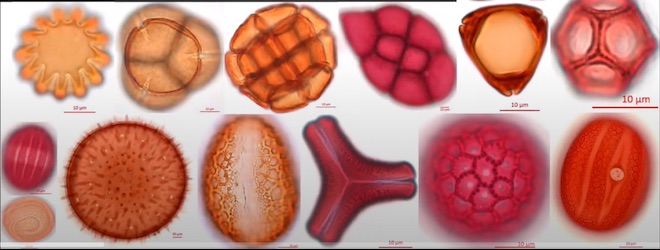What Can Pollen Tell Us?
By Ann M. Mason, Fairfax Master Gardener
While many of us curse wind-borne pollen that triggers reactions like sneezing and itchy eyes, as gardeners, we celebrate pollen for its role in plant reproduction and seed formation. But there is much more to this tiny, tough-walled particle. Until the development and refinement in micro imaging technology, including the invention of scanning electron microscope and image layering (stacked images to give a 3-dimensional view), the study of pollen was rudimentary.
In the mid-20th century, innovations in imaging technology and in archaeology, paleontology and geology advanced to make detailed study of pollen, spores and other micro-organic materials possible. Now this study has become a bona fide sub-science of botany called palynology. Palynology comes from the Greek word meaning ‘sprinkled’ or ‘strewn.’ While the study of all micro materials is fascinating, in this article we are going to focus on the study of pollen.
What can pollen tell us? Lots! Pollen has a hard biopolymer shell made up of sporopollenin, whose chemical composition eluded scientists until recently. Sporopollenin is made up of long chain fatty acids, phenylpropanoids, phenolic compounds and traces of carotenoids. The bottom line is that, because of this hard biopolymer shell, a pollen grain is long lasting — longer lasting than the plant the pollen came from and more available than fossil evidence of the plant itself.
We have heard a lot about seed banks storage to protect species for future generations. Storing pollen grains is just as important for those plants whose seeds are sensitive to desiccation (i.e., oaks, chestnuts and horse chestnuts) in conventional seed banks.
The pollen from each species of plant has a unique shape, orientation, surface pattern and morphology type — all of which help scientists (palynologists) create a pollen fingerprint — a signature from which scientists use to derive a lot of information.

Examples of the diverse shapes of pollen grains
For example, forensic palynologists assist crime scene investigators identify the location of a suspect or victim by looking at the pollen adhering to clothes. Since each habitat has a different combination of plants, the pollen mixture retrieved from clothing can narrow a geographic location. Pollen retrieved from artifacts or confiscated materials can help officials determine the provenance of an item like an art object or the origin of a counterfeit article.
Looking into the geologic record, palynologists working with industry geologists have learned to look in rocks and sediments for pollen associated ferns and other plants associated with oil deposits. Investigation of pollen grains and other organic matter in sedimentary rocks not only date the age of rock formations but also suggest the environmental conditions, including temperature, present during that age.
Working with archaeologists, anthropologists or other scientists, palynologists look at ancient pollen grains to identify the plants that formed the habitat of ancient peoples and cultures. And pollen grains can be found in the scat of animals and preserved feces of humans to help derive and reconstruct the diets of long absent beings. This also contributes to creating a picture of the biodiversity and habitat populated by these animals and beings long ago. For example, scientists now understand that Antarctica once had a temperate climate resplendent with ferns.
Today, as climate changes shift weather patterns, scientists are using the modern-day pollen record to identify the plant species and their pollinators associated with an ecosystem. Scientists are studying pollen grains clinging to collected bees, beetles and other pollinators to identify what plants they frequented. Through the identification of the pollen and pollinators interaction, scientists can build a library (database) of the ecosystem services provided by pollinators. Creating a database of plant-pollinator interrelationship and the biodiversity of an ecosystem might help us maintain and possibly restore our habitats. A group of scientists in Australia have undertaken an ambitious project to catalogue and build a library of Australia’s pollinator species interactions to monitor climate changes as well as the effectiveness of the pollinator services.
And if you are a connoisseur of special honeys, specialized palynologists are investigating the pollen in honey to identify the unique blends of flower nectar from source plants that gives some honey its unique taste.
So, what do we learn from pollen? By studying pollen and its unique signatures, we get insights into the biodiversity of historic habitats, population behaviors and patterns, and resource use. We can solve murder and counterfeit mysteries. And we can understand better our current plant-pollinator interactions with the possibility of monitoring for habitat alterations and influences of a changing climate.
Thus, study of the lowly pollen grain provides us with new insights into complex mysteries linked to an understanding of our biodiversity past and present.
Resources
• Every pollen grain has a story, Jonathan Drori, Ted Talk (2010)
• Pollen under the microscope, CSIRO (Commonwealth Scientific and Industrial Research Organization),
Australia National University
• With Palynology we can see the tiniest details, Matthew Mason, Environmental Science
• Palynology, University of Texas
• Pollen training and morphology part 1: Shapes and Orientation. Florida Institute of Technology
• Pollen training and morphology part 2: Apertures, Florida Institute of Technology